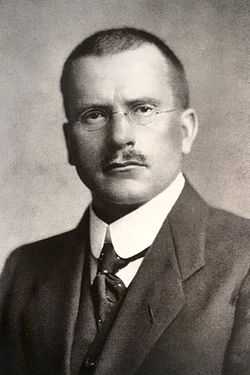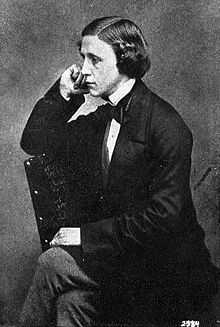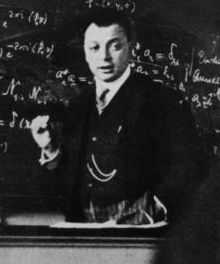Synchronicity

Synchronicity is the occurrence of two or more events that appear to be meaningfully related but not causally related. Synchronicity holds that such events are "meaningful coincidences". The concept of synchronicity was first defined by Carl Jung, a Swiss psychiatrist, in the 1920s.[1] During his career, Jung furnished several slightly different definitions of it.[2]
Jung variously defined synchronicity as an "acausal connecting (togetherness) principle," "meaningful coincidence," and "acausal parallelism." He introduced the concept as early as the 1920s but gave a full statement of it only in 1951 in an Eranos lecture.[3]
In 1952, he published a paper "Synchronizität als ein Prinzip akausaler Zusammenhänge" (Synchronicity – An Acausal Connecting Principle)[4] in a volume which also contained a related study by the physicist and Nobel laureate Wolfgang Pauli.[5]
Synchronicity implies that, just as events may be connected by causality, they may also be connected by meaning. Events connected by meaning need not have an explanation in terms of causality; this contradicts the Axiom of Causality in specific cases but does not contradict causality generally.
In his book Synchronicity: An Acausal Connecting Principle, Jung wrote:[6]
How are we to recognize acausal combinations of events, since it is obviously impossible to examine all chance happenings for their causality? The answer to this is that acausal events may be expected most readily where, on closer reflection, a causal connection appears to be inconceivable.
In the introduction to his book, Jung on Synchronicity and the Paranormal, Roderick Main wrote:[7]
The culmination of Jung's lifelong engagement with the paranormal is his theory of synchronicity, the view that the structure of reality includes a principle of acausal connection which manifests itself most conspicuously in the form of meaningful coincidences. Difficult, flawed, prone to misrepresentation, this theory none the less remains one of the most suggestive attempts yet made to bring the paranormal within the bounds of intelligibility. It has been found relevant by psychotherapists, parapsychologists, researchers of spiritual experience and a growing number of non-specialists. Indeed, Jung's writings in this area form an excellent general introduction to the whole field of the paranormal.
Arthur Koestler wrote extensively on synchronicity in his 1972 book The Roots of Coincidence.[8]
Description

Jung coined the word "synchronicity" to describe "temporally coincident occurrences of acausal events."
In his book Synchronicity: An Acausal Connecting Principle, he wrote:[6]
...it is impossible, with our present resources, to explain ESP, or the fact of meaningful coincidence, as a phenomenon of energy. This makes an end of the causal explanation as well, for "effect" cannot be understood as anything except a phenomenon of energy. Therefore it cannot be a question of cause and effect, but of a falling together in time, a kind of simultaneity. Because of this quality of simultaneity, I have picked on the term "synchronicity" to designate a hypothetical factor equal in rank to causality as a principle of explanation.
Synchronicity was a principle which, Jung felt, gave conclusive evidence for his concepts of archetypes and the collective unconscious.[9] It described a governing dynamic which underlies the whole of human experience and history — social, emotional, psychological, and spiritual. The emergence of the synchronistic paradigm was a significant move away from Cartesian dualism towards an underlying philosophy of double-aspect theory. It has been argued that this shift was essential to bringing theoretical coherence to Jung's earlier work.[10][11]
Even at Jung's presentation of his work on synchronicity in 1951 at an Eranos lecture, his ideas on synchronicity were evolving. On Feb. 25, 1953, in a letter to Carl Seelig, the Swiss author and journalist who wrote a biography of Albert Einstein. Jung wrote, “Professor Einstein was my guest on several occasions at dinner. . . These were very early days when Einstein was developing his first theory of relativity [and] It was he who first started me on thinking about a possible relativity of time as well as space, and their psychic conditionality. More than 30 years later the stimulus lead to my relation with the physicist professor W. Pauli and to my thesis of psychic synchronicity.”[4] Following discussions with both Albert Einstein and Wolfgang Pauli, Jung believed that there were parallels between synchronicity and aspects of relativity theory and quantum mechanics.[12] Jung was transfixed by the idea that life was not a series of random events but rather an expression of a deeper order, which he and Pauli referred to as Unus mundus. This deeper order led to the insights that a person was both embedded in an orderly framework and was the focus of that orderly framework and that the realisation of this was more than just an intellectual exercise, but also had elements of a spiritual awakening. From the religious perspective, synchronicity shares similar characteristics of an "intervention of grace". Jung also believed that in a person's life, synchronicity served a role similar to that of dreams, with the purpose of shifting a person's egocentric conscious thinking to greater wholeness.

A close associate of Jung, Marie-Louise von Franz, stated towards the end of her life that the concept of synchronicity must now be worked on by a new generation of researchers.[13] For example, in the years since the publication of Jung’s work on synchronicity, some writers largely sympathetic to Jung's approach have taken issue with certain aspects of his theory, including the question of how frequently synchronicity occurs.
One of Jung's favourite quotes[14] on synchronicity was from Through the Looking-Glass by Lewis Carroll, in which the White Queen says to Alice: "It's a poor sort of memory that only works backwards."[15]
"The rule is, jam to-morrow and jam yesterday—but never jam to-day."
"It MUST come sometimes to 'jam to-day,'" Alice objected.
"No, it can't," said the Queen. "It's jam every OTHER day: to-day isn't any OTHER day, you know."
"I don't understand you," said Alice. "It's dreadfully confusing!"
"That's the effect of living backwards," the Queen said kindly: "it always makes one a little giddy at first—"
"Living backwards!" Alice repeated in great astonishment. "I never heard of such a thing!"
"—but there's one great advantage in it, that one's memory works both ways."
"I'm sure MINE only works one way," Alice remarked. "I can't remember things before they happen."
"It's a poor sort of memory that only works backwards," the Queen remarked.
Examples
In his book Synchronicity (1952), Jung tells the following story as an example of a synchronistic event:
My example concerns a young woman patient who, in spite of efforts made on both sides, proved to be psychologically inaccessible. The difficulty lay in the fact that she always knew better about everything. Her excellent education had provided her with a weapon ideally suited to this purpose, namely a highly polished Cartesian rationalism with an impeccably “geometrical” idea of reality. After several fruitless attempts to sweeten her rationalism with a somewhat more human understanding, I had to confine myself to the hope that something unexpected and irrational would turn up, something that would burst the intellectual retort into which she had sealed herself. Well, I was sitting opposite her one day, with my back to the window, listening to her flow of rhetoric. She had an impressive dream the night before, in which someone had given her a golden scarab — a costly piece of jewellery. While she was still telling me this dream, I heard something behind me gently tapping on the window. I turned round and saw that it was a fairly large flying insect that was knocking against the window-pane from outside in the obvious effort to get into the dark room. This seemed to me very strange. I opened the window immediately and caught the insect in the air as it flew in. It was a scarabaeid beetle, or common rose-chafer (Cetonia aurata), whose gold-green colour most nearly resembles that of a golden scarab. I handed the beetle to my patient with the words, "Here is your scarab." This experience punctured the desired hole in her rationalism and broke the ice of her intellectual resistance. The treatment could now be continued with satisfactory results.[16]
The French writer Émile Deschamps claims in his memoirs that, in 1805, he was treated to some plum pudding by a stranger named Monsieur de Fontgibu. Ten years later, the writer encountered plum pudding on the menu of a Paris restaurant and wanted to order some, but the waiter told him that the last dish had already been served to another customer, who turned out to be de Fontgibu. Many years later, in 1832, Deschamps was at a dinner and once again ordered plum pudding. He recalled the earlier incident and told his friends that only de Fontgibu was missing to make the setting complete – and in the same instant, the now senile de Fontgibu entered the room.[17]
Jung wrote, after describing some examples, "When coincidences pile up in this way, one cannot help being impressed by them – for the greater the number of terms in such a series, or the more unusual its character, the more improbable it becomes."[18]

In his book Thirty Years That Shook Physics – The Story of Quantum Theory (1966), George Gamow writes about Wolfgang Pauli, who was apparently considered a person particularly associated with synchronicity events. Gamow whimsically refers to the "Pauli effect", a mysterious phenomenon which is not understood on a purely materialistic basis, and probably never will be. The following anecdote is told:
It is well known that theoretical physicists cannot handle experimental equipment; it breaks whenever they touch it. Pauli was such a good theoretical physicist that something usually broke in the lab whenever he merely stepped across the threshold. A mysterious event that did not seem at first to be connected with Pauli's presence once occurred in Professor J. Franck's laboratory in Göttingen. Early one afternoon, without apparent cause, a complicated apparatus for the study of atomic phenomena collapsed. Franck wrote humorously about this to Pauli at his Zürich address and, after some delay, received an answer in an envelope with a Danish stamp. Pauli wrote that he had gone to visit Bohr and at the time of the mishap in Franck's laboratory his train was stopped for a few minutes at the Göttingen railroad station. You may believe this anecdote or not, but there are many other observations concerning the reality of the Pauli Effect! [19]
Relationship with causality
Causality, when defined expansively (as for instance in the Kybalion or in the Axiom of Causality), states that "nothing can happen without being caused." Such an understanding of causality is incompatible with synchronicity.
Other definitions of causality (for example, the neo-Humean definition) are concerned only with the relation of cause to effect. As such, they are compatible with synchronicity.
There are also opinions which hold that, where there is no external observable cause, the cause can be internal.[20]
It is also pointed out, that since Jung took into consideration only the narrow definition of causality: only the efficient cause, his notion of "acausality" is also narrow and so is not applicable to final and formal causes as understood in aristotelian or thomism systems.[21] The final causality is inherent[22] in synchronicity (because it leads to individuation) or synchronicity can be a kind of replacement for final causality, such finalism is often controversial in science.
Criticisms
Critics assert that standard science, causality, physics, statistics, and probability (for instance, Littlewood's law or the law of truly large numbers) suffice to explain synchronistic events.[23][24] They deem them to be mere "normal events of low probability" when a single sample is being considered. And for a truly large number of samples, synchronistic events are likely to happen.<ref name=forbes/
Among some psychologists, Jung's works, such as The Interpretation of Nature and the Psyche, were received as problematic. Fritz Levi, in his 1952 review in Neue Schweizer Rundschau (New Swiss Observations), critiqued Jung's theory of synchronicity as vague in determinability of synchronistic events, saying that Jung never specifically explained his rejection of "magic causality" to which such an acausal principle as synchronicity would be related. He also questioned the theory's usefulness.[25]
In psychology and cognitive science, confirmation bias is a tendency to search for or interpret new information in a way that confirms one's preconceptions, and avoids information and interpretations that contradict prior beliefs. It is a type of cognitive bias and represents an error of inductive inference, or is a form of selection bias toward confirmation of the hypothesis under study, or disconfirmation of an alternative hypothesis. Confirmation bias is of interest in the teaching of critical thinking, as the skill is misused if rigorous critical scrutiny is applied only to evidence that challenges a preconceived idea, but not to evidence that supports it.[26]
Likewise, in psychology and sociology, the term apophenia is used for the apparent detection of a pattern or meaning in random or meaningless data.[27] Skeptics, such as Robert Todd Carroll of the Skeptic's Dictionary, argue that the perception of synchronicity is better explained as apophenia. Primates use pattern detection in their form of intelligence,[28] and this can lead to erroneous identification of non-existent patterns. A famous example of this is the fact that human face recognition is so robust, and based on such a basic archetype (essentially two dots and a line contained in a circle), that human beings are very prone to identify faces in random data all through their environment, like the "man in the moon", or faces in wood grain, an example of the visual form of apophenia known as pareidolia.[29]
It has been asserted that Jungian psychology's theory of synchronicity is equivalent to intellectual intuition.[30]
In some cases, synchronicity may cause a kind of mental laziness and a temptation to "(prematurely) give up trying to find a causal explanation."[31]
Publications
- Jung, Carl (1972). Synchronicity – An Acausal Connecting Principle. Routledge and Kegan Paul. ISBN 0-7100-7397-6.
- Jung, Carl (1977). Jung on Synchronicity and the Paranormal: Key Readings. Routledge. ISBN 0-415-15508-8.
- Jung, Carl (1981). The Archetypes and the Collective Unconscious. Princeton University Press. ISBN 0-691-01833-2.
See also
- Apophenia
- Black box theory
- Confirmation bias
- Correlation does not imply causation
- Emergence
- Leibniz’s Monadology as an assault on rationality
- Library angel
- Look-elsewhere effect
- Mathematical coincidence
- Multiple discovery
- Paul Kammerer, seriality theory
- Post hoc ergo propter hoc
- Pratītyasamutpāda (Buddhist notion of interdependent co-arising)
- Propinquity
- Rupert Sheldrake, philosophy of morphic resonance
- Semiotics
- Selection bias
- Superluminal communication
References
- ↑ Tarnas, Richard (2006). Cosmos and Psyche. New York: Penguin Group. p. 50. ISBN 0-670-03292-1.
- ↑ Bernard D. Beitman (2009) "Coincidence Studies: A Freudian Perspective..."
- ↑ Casement, Ann, "Who Owns Jung?", Karnac Books, 2007. ISBN 1-85575-403-7. Cf. page 25.
- ↑ 4.0 4.1 Jung, Carl G. (1993) [1952]. Synchronicity: An Acausal Connecting Principle. Bollingen, Switzerland: Bollingen Foundation. ISBN 978-0-691-01794-5.
- ↑ Roderick Main (2000). "Religion, Science, and Synchronicity". Harvest: Journal for Jungian Studies.
- ↑ 6.0 6.1 Jung, Carl (1973). Synchronicity: An Acausal Connecting Principle (first Princeton/Bollingen paperback ed.). Princeton, New Jersey: Princeton University Press. p. 8. ISBN 978-0-691-15050-5.
- ↑ Roderick, Main (1997). Jung on Synchronicity and the Paranormal. Princeton University Press. p. 1.
- ↑ Koestler, Arthur (1973). The Roots of Coincidence. Vintage. ISBN 0-394-71934-4.
- ↑ Jung defined the collective unconscious as akin to instincts in Archetypes and the Collective Unconscious.
- ↑ Brown, R.S. (2014). Evolving Attitudes. International Journal of Jungian Studies, 6.3, 243-253.
- ↑ In Synchronicity in the final two pages of the Conclusion, Jung stated that not all coincidences are meaningful and further explained the creative causes of this phenomenon.
- ↑ Igor V. Limar (2011). "Carl G. Jung’s Synchronicity and Quantum Entanglement: Schrödinger’s Cat ‘Wanders’ Between Chromosomes". NeuroQuantology 09 (2): 313. Archived from the original on 2011-06-30.
- ↑ Tarnas, Richard, "Cosmos and Psyche", 2006, Penguin Group, New York, Pgs 50–60
- ↑ Lecture notes, Jung Foundation, New York City, 1980s.
- ↑ Through the Looking-Glass, by Lewis Carroll, Chapter 5, Wool and Water.
- ↑ Jung, C.G. (1969). Synchronicity: An Acausal Connecting Principle. Princeton, New Jersey: Princeton University Press. pp. 109–110. ISBN 978-0-691-15050-5.
- ↑ Emile Deschamps, Oeuvres completes : Tomes I–VI, Reimpr. de l'ed. de Paris 1872–74
- ↑ C. G. Jung Jung on Synchronicity and the Paranormal, p. 91
- ↑ Thirty Years That Shook Physics – The Story of Quantum Theory, George Gamow, p. 64, Doubleday & Co. Inc. New York, 1966
- ↑ Psychologies of Mind: The Collected Papers of John Maze, edited by Rachael Henry
- ↑ James Arraj (1996) The Mystery of Matter: Nonlocality, Morphic Resonance, Synchronicity and the Philosophy of Nature of St. Thomas Aquinas, ch. 8. Synchronicity and Formal Causality
- ↑ Victor Mansfield, (1995), Synchronicity, Science and Soul-Making: Understanding Jungian Synchronicity Through Physics, Buddhism, and Philosophy
- ↑ John Navin, interview with David Hand, (2014), Why Coincidences, Miracles And Rare Events Happen Every Day, Forbes.com
- ↑ David Lane & Andrea Diem Lane, 2010, DESULTORY DECUSSATION Where Littlewood’s Law of Miracles meets Jung’s Synchronicity, www.integralworld.net
- ↑ Bishop, Paul (2000). Synchronicity and Intellectual Intuition in Kant, Swedenborg, and Jung. The Edwin Mellen Press. pp. 59–62. ISBN 0-7734-7593-1.
- ↑ Tim van Gelder, "Heads I win, tails you lose": A Foray Into the Psychology of Philosophy
- ↑ Brugger, Peter. "From Haunted Brain to Haunted Science: A Cognitive Neuroscience View of Paranormal and Pseudoscientific Thought", Hauntings and Poltergeists: Multidisciplinary Perspectives, edited by J. Houran and R. Lange (North Carolina: McFarland & Company, Inc. Publishers, 2001).
- ↑ Pattern recognition of behavioral events in the nonhuman primate
- ↑ Svoboda, Elizabeth (13 February 2007). "Facial Recognition – Brain – Faces, Faces Everywhere". New York Times. Retrieved July 2010.
- ↑ Bishop, pp. 17–20.
- ↑ Charles Tart, Causality and Synchronicity - Steps Toward Clarification, (1981), Journal of the American Society for Psychical Research, vol. 75, pp. 121-141.
Bibliography
- Aziz, Robert (1990). C.G. Jung's Psychology of Religion and Synchronicity (10 ed.). The State University of New York Press. ISBN 0-7914-0166-9.
- Aziz, Robert (1999). "Synchronicity and the Transformation of the Ethical in Jungian Psychology". In Becker, Carl. Asian and Jungian Views of Ethics. Greenwood. ISBN 0-313-30452-1.
- Aziz, Robert (2007). The Syndetic Paradigm: The Untrodden Path Beyond Freud and Jung. The State University of New York Press. ISBN 978-0-7914-6982-8.
- Aziz, Robert (2008). "Foreword". In Storm, Lance. Synchronicity: Multiple Perspectives on Meaningful Coincidence. Pari Publishing. ISBN 978-88-95604-02-2.
- Carey, Harriet (1869). "Monsieur de Fontgibu and the Plum Pudding". Echoes from the Harp of France. p. 174.
- Cederquist, Jan (2010). Meaningful Coincidence. Times Publishing Limited. ISBN 978-0-462-09970-5.
- Combs, Allan; Holland, Mark (2001). Synchronicity: Through the Eyes of Science, Myth, and the Trickster. New York: Marlowe. ISBN 1-56924-599-1.
- Franz, Marie-Louise von (1980). On Divination and Synchronicity: The Psychology of Meaningful Chance. Inner City Books. ISBN 0-919123-02-3.
- Jaworski, Joseph (1996). Synchronicity: the inner path of leadership. Berrett-Koehler Publishers Inc. ISBN 1-881052-94-X.
- Gieser, Suzanne (2005). The Innermost Kernel. Depth Psychology and Quantum Physics. Wolfgang Pauli's Dialogue with C.G. Jung. Springer Verlag.
- Haule, John Ryan (2010). Jung in the 21st Century: Synchronicity and science. Routledge. ISBN 0-203-83360-0.
- Koestler, Arthur (1973). The Roots of Coincidence. Vintage. ISBN 0-394-71934-4.
- Main, Roderick (2007). Revelations of Chance: Synchronicity as Spiritual Experience. The State University of New York Press. ISBN 0-7914-7024-5.
- Mardorf, Elisabeth. Das kann doch kein Zufall sei (in German).
- Mansfield, Victor (1995). Science, Synchronicity and Soul-Making. Open Court Publishing Company. ISBN 0-8126-9304-3.
- Peat, F. David (1987). Synchronicity, The Bridge Between Matter and Mind. Bantam. ISBN 0-553-34676-8.
- Progoff, Ira (1973). Jung, synchronicity, & human destiny: Noncausal dimensions of human experience. New York, Julian Press. ISBN 0-87097-056-9. OCLC 763819.
- Wilhelm, Richard (1986). Lectures on the I Ching: Constancy and Change Bollingen edition. Princeton University Press; Reprint. ISBN 0-691-01872-3.
- Roth, Remo, F., Return of the World Soul, Wolfgang Pauli, C.G. Jung and the Challenge of Psychophysical Reality [unus mundus]. Pari Publishing, 2011
External links
| Wikiquote has quotations related to: Synchronicity |
